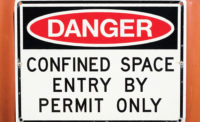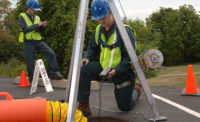Date adopted: May 4, 2015
Back story
OSHA has enforced a confined spaces standard for general industry since 1993, one which mandates procedures and requirements for working in an area not intended for continuous occupancy with limited means of entry and exit. Due to the complexity and continually evolving state of construction sites, the agency in 2015 issued a new standard for confined spaces specifically for construction.
While the standard’s effective date was August 3, 2015, OSHA responded to industry requests for an extension in order to conduct training by postponing full enforcement of the new standard to October 2, 2015. During that period, OSHA did not issue citations to employers who made good faith efforts to comply with the new standard. Compliance with the training and personal protective equipment requirements of the standard were some of the factors the agency considered when evaluating whether an employer was engaged in a goof faith effort.
Scope
Any entity doing construction work, such as building a new structure or upgrading an old one, must follow the construction confined space rule. Because the new rule applies to all employers who perform construction activities in a confined space, safety managers in all industries should become familiar with the standard. Confined spaces are defined as spaces large enough for an employee to enter but with limited means of entry or exit, and spaces which are not designed for continuous occupancy.
Key hazards
People working in confined spaces face life-threatening hazards including toxic substances, electrocutions, explosions, and asphyxiation. These atmospheric hazards can be prevented if addressed prior to entering the space to perform work.
According to data collected by the U.S. Department of Labor, Bureau of Labor Statistics Census of Fatal Occupational Injuries program, fatal injuries in confined spaces fluctuated from a low of 81 in 1998 to a high of 100 in 2000 during the five-year period, averaging 92 fatalities per year.
Benefits of the standard
In issuing the standard, OSHA cited research showed proper safety procedures would protect hundreds of workers each year from life-threatening hazards.
Key provisions
- Identification of permit-required confined spaces: Before beginning work on a project, each employer must ensure that a competent person identifies all confined spaces in which one or more employees it directs may work and identifies each space that is a permit-required confined space. Permit-required confined spaces can be immediately dangerous to workers’ lives if not properly identified, evaluated, tested and controlled. Permit-required confined spaces contain the potential to contain a hazardous atmosphere or a material that has the potential for engulfing an entrant. They may also have an internal configuration such that an entrant could be trapped or asphyxiated by inwardly converging walls or by a floor which slopes downward and tapers to a smaller cross-section.
- Notification: If a workplace contains a permit-required confined space, the entry employer must inform workers in the vicinity of each space of the location and danger posed by that space. This can be done by posting and positioning warning signs at each possible point of entry.
- Personal protective equipment: Entry employers allowing an employee to enter a permit space must attempt to eliminate or isolate the hazards in the space. When engineering and work practice controls do not adequately protect employees, they must assess the space to determine what personal protective equipment (PPE) is needed to protect workers. Entry employers must provide workers with the required PPE and proper training on its use and about any related hazards before the work starts.
- Training: Workers must be informed about the existence and location of, and dangers posed by, each permit-required confined space, and that they may not enter such spaces without authorization. Entry employers must train workers involved in permit-required confined space operations so that they can perform their duties safely and understand the hazards in permit spaces and the methods used to isolate, control or protect workers.
- A written entry program: The permit-required confined space program must establish a system for preparing, using, and canceling entry permits, which are written or printed documents that allow and control entry into permit spaces.
Enforcement case studies
An enforcement case finalized in April 2016 in which a worker suffered fatal injuries was among the first in which citations were issued under the confined space in construction standard. While the worker was killed by the rupture of inflatable bladder – and his employer was cited for failing to train him properly on how to test joints safely – OSHA investigators also found confined space violations related to the 54-inch pipe the worker was in at the time of the accident.
Henderson Construction of Central Illinois Inc. and three other contractors working on a renovation of the Springfield Metro Sanitary District’s Sugar Creek Plant were cited failing to manage how and when workers entered the large round pipe. The agency found the four companies failed to continuously monitor confined spaces for atmospheric and other hazards and train workers in hazards. Proposed fines for these and other safety violations totaled $120,600 for the four companies.
In another enforcement case, a worker who drowned as the result of a fall was actually a victim of confined space hazards. At the site of a $250 million single-family residence being constructed in Bel Air, California a construction worker entered a 4 ½’ diameter concrete-lined drainage shaft to clean out mud and debris. He was inside a bucket being lowered into the shaft by a mini crawler crane and had descended about ten feet when he lost consciousness due to the oxygen deficient atmosphere. The worker, who had no personal fall protection, fell approximately 40 feet and drowned in one foot of water.
Cal/OSHA found that neither the man’s employer, subcontractor D&D Construction Specialties nor the general contractor on the project, Tyler Development, followed permit required confined space procedures at the worksite. D&D was cited for failure to ensure a safe entry into the confined space; have an effective method to rescue the worker in the confined space in an emergency, and test the environment to determine if additional protective equipment, such as a respirator or oxygen tank, were required to work safely in the shaft. Tyler was cited for failing to evaluate the worksite for possible permit-required confined spaces and ensure that the subcontractor meets all requirements to comply with a permit space program.
Compliance assistance
There are many resources available for employers seeking assistance in complying with the Confined Spaces in Construction Standard. “Frequently Asked Questions” covers everything from the basic (what is a confined space?) to the more nuanced (do I need to do anything if there are permit spaces at the worksite but my employees will not need to enter them?). Small companies may find it useful to consult “Protecting Construction Workers in Confined Spaces: Small Entity Compliance Guide.” An OSHA Fact Sheet entitled “Is 911 your Confined Space Rescue Plan?” guides employers in pre-planning to ensure that the rescue or emergency services they summon in the event of a confined space emergency are familiar with the exact site location, types of permit-required confined spaces and the rescue equipment necessary.



